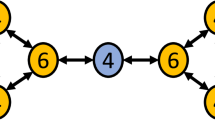Abstract
A CONTROVERSIAL model of speciation proposes that the development of alternative social organizations within populations of group-living animals may drive the inception of reproductive isolation1–3. The alternative social behaviours, which are selectively favoured in some social or ecological contexts, may be correlated with distinctive reproductive traits such that significant barriers to interbreeding emerge between coexisting social variants. Evidence for this mode of speciation is almost nonexistent3–8, but it provides one of the most compelling mechanisms for sympatric speciation3,8 and could conceivably explain many species origins. Here we examine variation in mito-chondrial DNA and two unique nuclear genes to demonstrate that gene flow between sympatric social forms of the fire ant Solenopsis invicta is restricted to only one of four possible routes. The loss of the other routes results from incompatibilities in the social systems of the two forms, demonstrating the potential for social selection to generate significant barriers to gene flow and to initiate reproductive isolation.
This is a preview of subscription content, access via your institution
Access options
Subscribe to this journal
Receive 51 print issues and online access
$199.00 per year
only $3.90 per issue
Buy this article
- Purchase on Springer Link
- Instant access to full article PDF
Prices may be subject to local taxes which are calculated during checkout
Similar content being viewed by others
References
West-Eberhard, M. J. Q. Rev. Biol 58, 155–183 (1983).
West-Eberhard, M. J. Proc. Natl Acad. Sci. USA 83, 1388–1392 (1986).
Bourke, A. F. G. & Franks, N. R. Biol. J. Linn. Soc. 43, 157–178 (1991).
Crozier, R. H. Annu. Rev. Entomol. 22, 263–288 (1977).
Buschinger, A. Trends Ecol. Evol. 1, 155–160 (1986).
Ward, P. S. in The Genetics of Social Evolution (eds Breed, M. D. & Page, R. E.) 123–148 (Westview, Boulder, 1989).
Buschinger, A. Z. Zool. Syst. Evol. Forsch. 28, 241–260 (1990).
Ross, K. G. & Keller, L. Annu. Rev. Ecol. Syst. 26, 631–656 (1995).
Ross, K. G., Vargo, E. L. & Keller, L. Evolution (in the press).
Ross, K. G. & Shoemaker, D. D. Evolution 47, 1595–1605 (1993).
Excoffier, L., Smouse, P. E. & Quattro, J. M. Genetics 131, 470–491 (1992).
Markin, G. P., Dillier, J. H., Hill, S. O., Blum, M. S. & Hermann, H. R. J. Georgia Entomol. Soc. 6, 145–156 (1971).
Ross, K. G. Nature 355, 347–349 (1992).
Keller, L. & Ross, K. G. Science 260, 1107–1110 (1993).
Ross, K. G. & Keller, L. Am. Nat. 146, 325–348 (1995).
Ross, K. G., Vargo, E. L. & Fletcher, D. J. C. Evolution 41, 979–990 (1987).
Markin, G. P., Collins, H. L. & Dillier, J. H. Ann. Entomol. Soc. Am. 65, 1053–1058 (1972).
Porter, S. D. J. Entomol. Sci. 26, 474–478 (1991).
Ross, K. G., Vargo, E. L. & Keller, L. Proc. Natl Acad. Sci. USA 93, 3021–3025 (1996).
Glancey, B. M. & Lofgren, C. S. Florida Entomol. 71, 581–587 (1988).
Tschinkel, W. R. & Howard, D. F. Behav. Ecol. Sociobiol. 12, 103–113 (1983).
Fletcher, D. J. C. & Blum, M. S. Science 219, 312–314 (1983).
Porter, S. D., Van Eimeren, B. & Gilbert, L. E. Ann. Entomol. Soc. Am. 81, 913–918 (1988).
Ross, K. G., Vargo, E. L., Keller, L. & Trager, J. C. Genetics 135, 843–854 (1993).
Vargo, E. L. J. Evol. Biol. (in the press).
Bourke, A. F. G. & Franks, N. R. Social Evolution in Ants (Princeton Univ. Press, Princeton, NJ, 1995).
Crozier, R. H. & Crozier, Y. C. Genetics 133, 97–117 (1993).
Shoemaker, D. D., Costa, J. T. & Ross, K. G. Heredity 69, 573–582 (1992).
Author information
Authors and Affiliations
Rights and permissions
About this article
Cite this article
Shoemaker, D., Ross, K. Effects of social organization on gene flow in the fire ant Solenopsis invicta. Nature 383, 613–616 (1996). https://doi.org/10.1038/383613a0
Received:
Accepted:
Issue Date:
DOI: https://doi.org/10.1038/383613a0
This article is cited by
-
The Interplay between Incipient Species and Social Polymorphism in the Desert Ant Cataglyphis
Scientific Reports (2019)
-
Unexpected patterns of segregation distortion at a selfish supergene in the fire ant Solenopsis invicta
BMC Genetics (2018)
-
Phylogeography of social polymorphism in a boreo-montane ant
BMC Evolutionary Biology (2016)
-
External morphology and microstructure of the compound eye of fire ants, Solenopsis invicta Buren
Frontiers of Agriculture in China (2011)
-
Potential cause of lethality of an allele implicated in social evolution in fire ants
Genetica (2007)
Comments
By submitting a comment you agree to abide by our Terms and Community Guidelines. If you find something abusive or that does not comply with our terms or guidelines please flag it as inappropriate.



